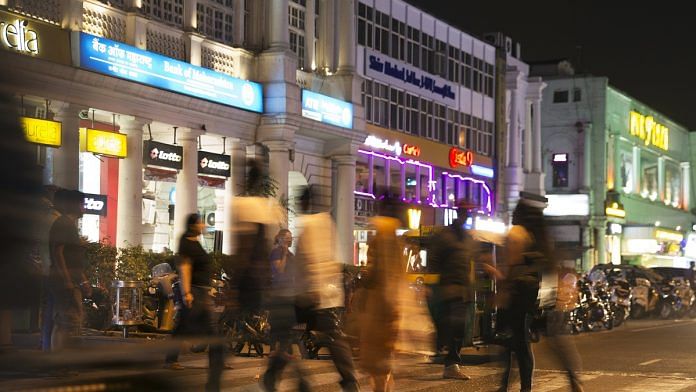An assumption that problems in the Chinese economy would automatically lead to more opportunities for India needs closer examination.
China’s economy grew 6.6 per cent last year, the slowest in 28 years, said official reports released Monday. But those who are over-optimistic about India closing the gap with China need to keep the champagne on ice.
China’s Gross Domestic Product (GDP) numbers are the latest reminder of the slowing growth and troubles facing the world’s second-largest economy, currently in the midst of a bruising trade war with the United States.
Slowing growth in a country that has been the lynchpin of the global economy has understandably caused concerns worldwide, particularly in the West, where many companies, from automakers to tech giants to luxury brands, have grown reliant on the Chinese market.
Also read: Amid trade war with US, China’s growth records slowest rate since 1990
But problems in the Chinese economy—as well as the continuing trade war with the US—have understandably been seen in many Indian quarters as an opportunity. That India’s economy is set to grow faster than China’s has also become a cause for celebration, highlighted by ministers in the Narendra Modi government as an indication that India was inching closer to its five-times-larger neighbour.
Both these assumptions, however, merit closer examination.
Let us first consider the extent of the slowdown of China’s economy—and the slowest growth since 1990.
As alarming as it sounds, what should also be noted, as The Economist journalist Simon Rabinovitch reminded us, is we are talking about a $13 trillion dollar economy growing at 6.6 per cent—as opposed to what was a $400 billion economy 28 years ago.
In other words, China still added $1.2 trillion in additional demand last year—or half the size of India’s economy.
So even while some are exultant about the prospects of growing faster than China, but as former foreign secretary Shyam Saran reminded us at a forum on China last month that even if China grows at zero per cent, India will have to grow at 10 per cent annually for the next 20 years to catch up, which seems improbable.
Also read: India to become bigger than China eventually, says former RBI governor Raghuram Rajan
Then there is the question of the advantages from China’s slowdown, which comes just as Beijing makes the long-overdue moves to import more from India to check the widening trade imbalance. In the first eight months of 2018-19, India’s exports to China increased by one-third, year-on-year, to $11.1 billion. The trade deficit still remains considerable, with India importing $48.35 billion in this period.
The Indian government has said it sees ‘a window of opportunity’ to expand India’s exports because of the trade war and retaliatory tariffs placed by China, particularly on several American agricultural commodities.
India has already discussed exporting soyabean, and Monday, both sides signed a protocol of phytosanitary requirements to export tobacco leaves. So the trade war certainly holds the promise of some trade advantages for India, at least in the short term. But whether the benefits would likely be somewhat offset by the general slump in China’s appetite for imports on account of its troubled economy remains far from clear.
What is more, a recent report by financial services firm Nomura Holdings found that on the two widely perceived gains by India and other third countries from the trade war—the second being moving production out of China, besides the gains from import substitution—there are other countries better placed than India to benefit.
Ranking countries on an import substitution index based on their relative specialisation in each product, the geographical distance to the US and the importance of a particular product, it found Malaysia was most likely to benefit, followed by Japan, Pakistan, Thailand and Philippines, based on analysing specific products that China had placed tariffs on.
Even when it comes to switching production out of China—which was based on FDI attractiveness and a survey of multinational companies—Nomura said Vietnam would be the clear winner.
India was placed fourth, behind Malaysia and Singapore.
So what emerges is a mixed picture for India’s prospects and gains from China’s troubles. As James Crabtree pointed out, there is also, in this mapping of winners and losers from a trade war, ‘a deeper misunderstanding about how trade disputes affect modern interconnected economies’.
Also read: Gap between India and China looks wider if we compare our states to their provinces
Labour issues
Moving out long-integrated supply chains is far from straightforward, as is finding the skilled labour, which as Apple CEO Tim Cook has pointed out, is an oft-overlooked factor in China’s attractiveness, which is wrongly attributed merely to low wages (which hasn’t been the case for at least a decade).
Does India have the skilled labour to match?
“The idea that entire industries in areas like electronics or smartphones would suddenly shift out of China and into nearby Asian economies is perhaps the most unlikely idea of all,” argues Crabtree.
“U.S. companies outsource production to coastal China because of its uniquely sophisticated production ecosystem. Apple could not make iPhones in America, even if it wanted to. The idea it could quickly shift all its iPhone production to much smaller economies like Malaysia and Vietnam is equally fanciful.”
So what matters more for India than China’s own domestic challenges, in the final analysis, are India’s own challenges at home, and what we are doing—or not doing—to address them.
(Ananth Krishnan is a Visiting Fellow at Brookings India and was formerly China correspondent for India Today and The Hindu).






